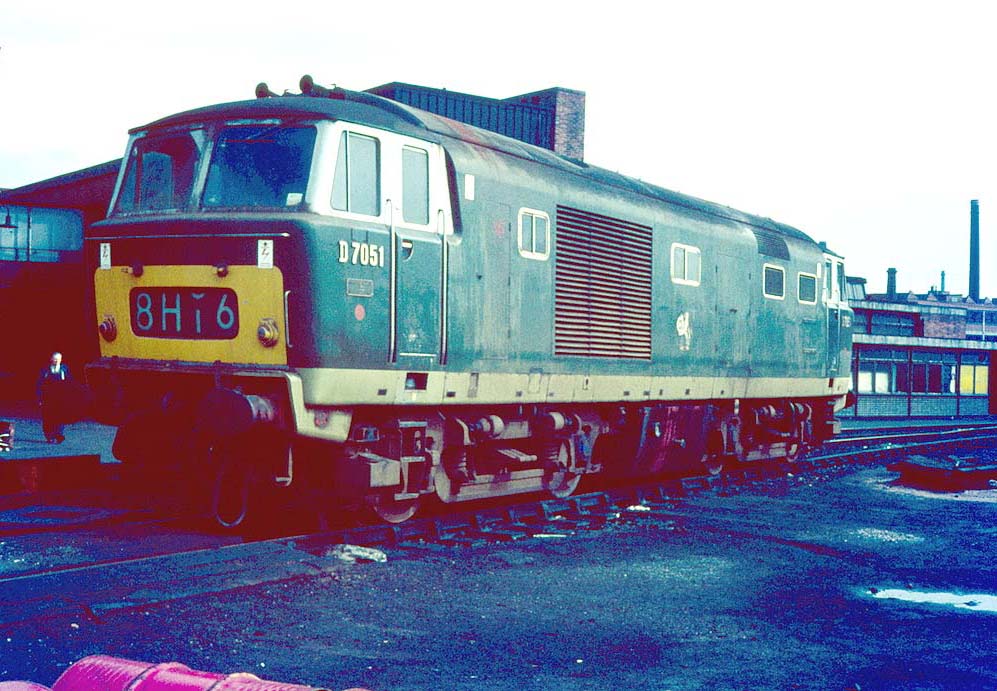 |
|
London North Western
Railway:

Midland
Railway:

Stratford
Midland Junction Railway
|

|
LMS Route: Nuneaton to Birmingham New Street
LMS Route: Birmingham New Street to Tamworth
Saltley Shed: mrsalt1246
 |
British Railways Western Region Hymek D7051 is seen standing
alongside Saltley shed's amenities block. The 'Hymek' class were unique by the
fact that they were the only Type 3 diesel-hydraulics to be built as this
design was not part of the Modernisation Plan for Britain's railways. Beyer
Peacock were hoping for a share of the diesel orders then being placed for
Britain's railways and were in fact building shunting locomotives plus 200 sets
of underframes for the Brush Type 2 locomotives. With an intention of supplying
complete locomotives for future orders, Beyer Peacock looked into the
possibility of building main-line diesel-hydraulics, and although BR employed
Type 2 D6300 class and Type 4 Warship class, no plans were announced for a Type
3 machine of 1501 to 1750 hp. In response, Beyer Peacock formed a consortium in
1958 with Bristol Siddeley Engines and J Stone of Deptford, named Beyer Peacock
(Hymek) Limited. Their design for a Type 3 locomotive featured a 16-cylinder
Maybach MD870 engine capable of 1,920 hp, coupled with the Mekydro K184U
transmission. Construction was to based at Beyer Peacock's Gorton works in
Manchester.
In June 1959, the BTC ordered an initial batch of 45
'Hymeks' at a cost of £80,000 each, but in July 1960, ten months before
the first 'Hymek' entered traffic, the BTC ordered a further 50 locomotives,
such was the confidence in the design. A final batch of 6 locomotives was
ordered in December 1961. The Maybach MD870 engine was basically a stretched
version of the MD655 engine to be used in the 'Western' class, but with four
intercoolers and two turbochargers. Power was reduced to 1,740 hp at 1500
rev/min to bring it in line with the Type 3 specification. Manufacture of the
engine was to be at Bristol Siddeley's engine plant at Ansty, near Coventry
although the first 20 units contained a number of parts from Germany.
Similarly, of the 116 sets of Mekydro transmissions, 91 were made by J Stone
with the remaining 25 built in Friedrichshafen. The stretched-skin type of body
construction so successfully used by the 'Warship' and 'Western' classes was
not required for the 'Hymeks'. With conventional construction and, of course, a
single engine and transmission, an adhesion weight of 75 tons was perfectly
satisfactory. In addition, the absence of special construction methods removed
the need for training of Beyer Peacocks workforce as well as entering into a
licencing agreement with the Germans.
The main load-bearing members of the 'Hymek' underframes
were longitudinal rolled steel joists to which lighter angle sections were
added to form the body framing. The body panels themselves were made from
lightweight sheets as they were non-loadbearing as shown by the use of
fibreglass mouldings for the cab roof. The bogie used on the 'Hymeks' was the
tried and trusted Commonwealth design, to which, wheels of 45 inches diameter
were fitted. This was an odd size for the Western Region as previous
diesel-hydraulic locomotives used wheels of 39½ or 43 inches diameter .
The first 'Hymek', number D7000, was handed over to the Western Region on the
16th May 1961 in a ceremony at Paddington station, almost two months ahead of
schedule, however, the last 'Hymek' number D7100 was held up until February
1964, after problems at Gorton caused a delay in delivery for almost twelve
months.
There were two main differences between the first and last
members of the class in that D7000 to D7044 were fitted with the Stone-Vapor
train heating boiler and brakes were of the Knorr straight air type together
with Laycock-Knorr compressors. Numbers D7045 to D7100 used the Spanner Mk.
IIIa train heating boiler and brakes and compressors were supplied by
Westinghouse. The location of the air horns on the first three members, which
was under the buffer beam, was moved to the cab roof on the remainder of the
class and those first members had their horns repositioned to the cab roof
also. Livery on all members of the class when delivered was Brunswick Green
with a light green band band running the full length of the locomotive at waist
height. In addition, the window surrounds were painted white. The running
numbers were an unusual feature of the class in that the cabside numbers where
made from cast aluminium. The 'Hymeks' did not receive the "TOPS" style of
numbering which would have been 'Class 35'.
Courtesy www.greatwestern.org.uk
 back back

|
